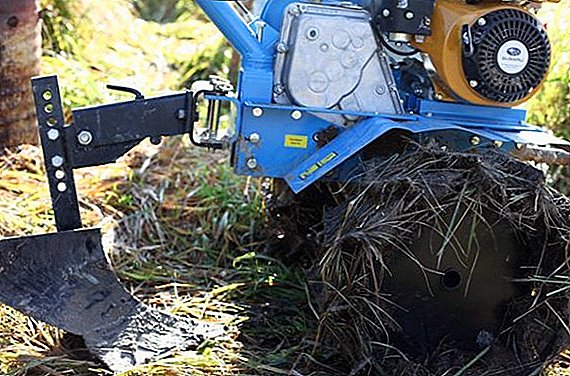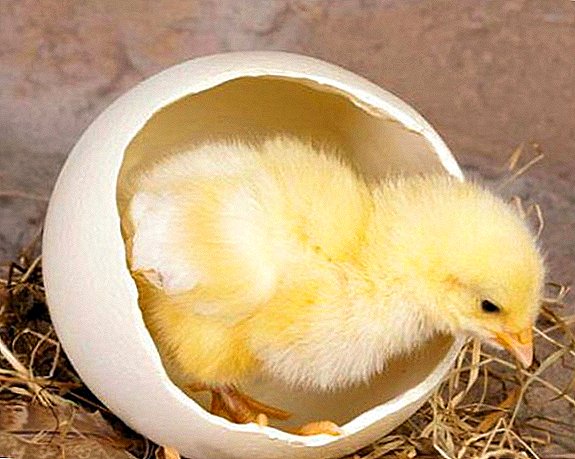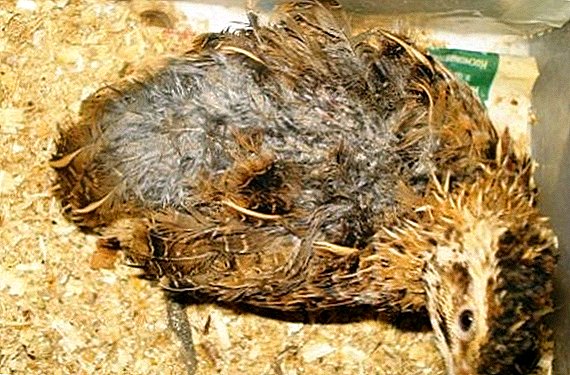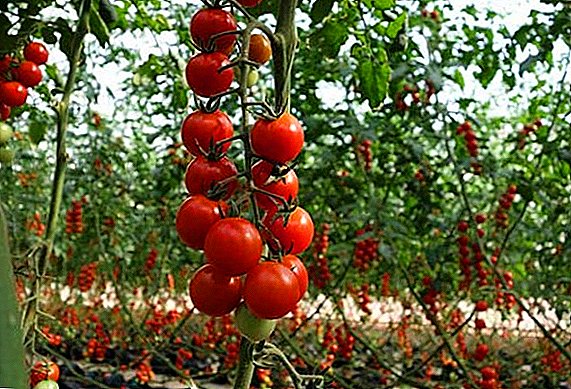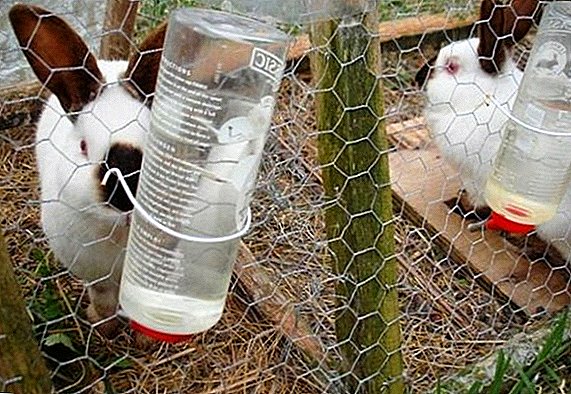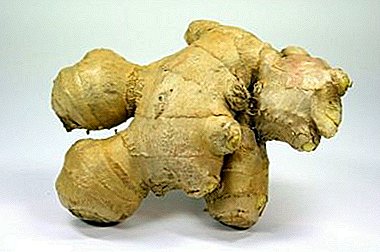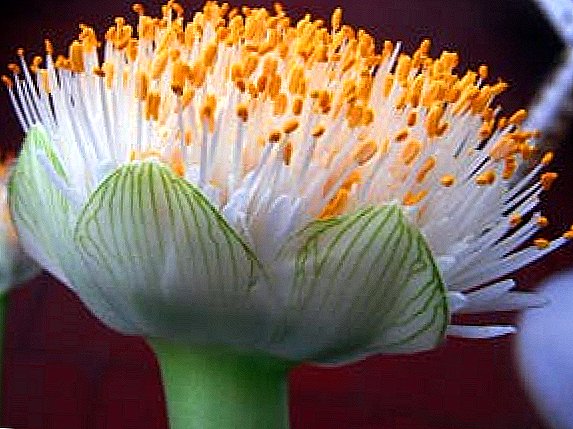 Often in the homes of flower lovers you can see a fancy plant called "reindeer tongue" or "elephant ear". But few know that this flower has the official name - gemantus. And even more, few people know that this bizarre plant has many varieties, and caring for it will not cause much trouble.
Often in the homes of flower lovers you can see a fancy plant called "reindeer tongue" or "elephant ear". But few know that this flower has the official name - gemantus. And even more, few people know that this bizarre plant has many varieties, and caring for it will not cause much trouble.
Flower description
Hemanthus (Haemanthus) - monocotyledonous bulbous flower of the amaryllis family with two to six large, sessile, short petiole, membranous-skin or fleshy leaves.
This species is a distant cousin of amaryllis, clivia, hippeastrum (hypeastrum), euharis. Translated from the Greek (Αίμα- blood and άνθος-germ, flower) gemantus means "bloody flower". Although, there are species with white and orange flowers.  In some species of gemantus, the resting phase occurs in winter and the plant sheds leaves. For others, the passive state does not exist at all — they are evergreen. Almost all varieties of this flower are unpretentious in their care.
In some species of gemantus, the resting phase occurs in winter and the plant sheds leaves. For others, the passive state does not exist at all — they are evergreen. Almost all varieties of this flower are unpretentious in their care.
Flowers during maturation produce nectar and a lot of pollen. This spreads a rather unpleasant odor. As a result of pollination on the arrow, a kidney is formed, which matures into a small fruit (1-2 cm in diameter) fragrant berry of white, carrot, bright cinnabar or pink color.  When ripe, the seeds of "elephant ear" become maroon.
When ripe, the seeds of "elephant ear" become maroon.
Important! Gemantus prone to self-pollination.
Types of gemantus
This plant has more than 50 species, most of which are found in the tropics and southern Africa.
In most cases, at home hematus of Katharina and the evergreen species of white flowers are bred. But naturalists note such, the most famous, species of this flower:
Plant hemantus belotsvetkovy or white (Haemanthus albiflos) in everyday life is called deer, damn or mother-in-law language, it is his photo that is usually found on the Internet when searching for this flower. The flower has received its unofficial name for dense, wide, in the form of tongue, dark green leaves, slightly pubescent along the hem. Peduncle small-15-25 cm. The flowering period is summer. 
Pomegranate gemantus (Haemanthus puniceus). Tuber round, medium size (7-8 cm). Leaves are light green, wrinkled, slightly wavy. The length of the leaves varies from 15 to 30 cm. The flowers are concentrated in the shape of an umbrella, large (8-10 cm). As a rule, 8-20 light scarlet or yellowish-red buds form on one plant. The flowering period is summer. 
Gemantus Katharina (Haemanthus Katharinae). View with a strong pseudostem. Bulb-medium, 6-8 cm. Long (up to 30 cm) leaves form in the upper part of the stem. The stem is high (15-30 cm), mottled at the base. The brushes are assembled in 20 cm umbrellas. During flowering (July-August), the plant produces numerous red flowers. For decoration deserves high praise. 
Cinnabar Hemanthus (Haemanthuscinnabarinus). Tuber-fine (3 cm), round. Leaves produces a little-2-4 pieces. The surface of the leaf is leathery, the shape is oval-elongated, length is 15-25 cm. The stem is parallel to the young leaves. Cinnabar-red buds are formed into umbrella-shaped brushes with a diameter of 10 cm. Moreover, 20-40 flowers are blooming on one pedicel. The flowering period is April. 
Gemanthus Linden (Haemanthus Lindenii). As a rule, this species produces 6 large (30 cm long, 10 cm wide) leathery leaves that grow in two rows. In the flowering phase, the gementus releases a 45 cm tall flower stalk, on which scarlet-red buds bloom, gathered into umbrellas. The flowers themselves are small, up to 5 cm. There are several garden forms of this species. 
Hematus of many flowers (Hamanthus multiflorus). View with a powerful (8 cm in diameter) bulb. Stem - undeveloped, false. It forms 3-6 leaves of 15-30 cm in length. Peduncle - tall (30-80 cm), green with reddish patches. The flowers are scarlet-red, small, with cinnabar stamens. Blooms in spring, 30-80 flowers form on the stem. 
Hemanthus snow white or pure white (Haemanthus candidus Bull). Similar to the white view. White flowers. 
Tiger gemantus (Haemanthus tigrinus). A flower with large, fleshy leaves 45 cm long. The stem is short, only 15 cm, slightly flattened. It is painted in light green color, decorated with red splashes. Blooms with red flowers, formed in a tight inflorescence size of 15 cm. 
Scarlet Gemantus (Haemanthus coccineus). Tuber-large, 10 cm. Fleshy (15-20 cm wide and 45-60 cm long), green, with red edging, leaves germinate after flowering in winter. Peduncle small, 15-25 cm, dotted with brown-red dots. Flowers are bright red, joined in an umbrella brush, up to 8 cm in diameter. 
Did you know? Gemantus was characterized by Carl Linnaeus as early as the middle of the 18th century. Scientists have long been deciding what kind of species it belongs to and only in the 20th century did gemantius be singled out as a separate genus..
Care
By its nature, hemantus is an undemanding plant, its care is simple and it takes root very well at home.
Lighting
Perhaps the most important condition for growing gemanthus is proper lighting. And it must strictly comply with it.
Most species need diffused light. Typically, such species have an established resting season, and when it sets in, they shed their leaves. In the resting phase, such plants are transferred to a dimly lit place.
For this flower, windows that look east or west are perfect. 
Evergreen species are best cultivated in the penumbra.
Temperature
The best temperature for all forms of hemantus is a common room- + 18-22 ° C. In the resting phase (October-February), the temperature should be + 10-12 ° C.
In the summer, the flower can be taken out on the balcony or loggia, but it must be controlled so that there are no drafts.
Important! Evergreen species of hemantus do not have a state of rest, therefore they do not need to reduce the temperature.
Watering
Water loves this flower, but you should not flood it. In addition, do not allow accumulation of water in the pan-it needs to be drained.
Watering gemantus need to carefully, at the root, to ensure that moisture does not fall on the leaves. Watering is carried out when the topsoil is completely dry.
Water should be used separated, not hard, room temperature. Perfectly filtered.
Easy drought gemantus not interfere.  In the fall, watering is reduced and only occasionally moisten the soil.
In the fall, watering is reduced and only occasionally moisten the soil.
Important! Humidity should be medium, hemantus should be sprayed only in the active phase.
Fertilizer
Hemantus is fed every 14-20 days and only during the active phase and flowering. To do this, apply mineral (with increased potassium and phosphorus) feed.
The plant responds well to liquid fertilizers for domestic flowering plants.
Transfer
So that gemantus does not lose its ability to bloom, it is transplanted every 2-3 years, in spring, and the description of this process deserves special attention.
Before transplanting, prepare fresh soil mixture: leaf (1 part), humus (0.5 portions) ground, turf (2 parts), river sand (1 portion) and peat (1 part). The tank should be free, wide, and below it is necessary to lay a drainage layer.
Tuber into the soil should not be deepened, it is better to leave a little above the ground.
Important! When replanting, care must be taken to ensure that the roots are not damaged.
Breeding
The reproduction of gemanthus is an attractive process, because this flower can multiply in several ways.
Seeds
Hematus seeds matured have a maroon shade. They are planted immediately after collection, because over time they lose their germination. Sprinkle seeds on wet soil and do not drip.  The first flowering of young plants, planted in the seed way, will come only after 5-6 years.
The first flowering of young plants, planted in the seed way, will come only after 5-6 years.
Did you know? What we used to call a flower, in gemanthus, in fact, is not. This is the concentration of stamens with colored specks..
Onion Babes
The second, more efficient method of breeding is an onion. In the spring of young tubers, which appeared near the mother bulb, are deposited in separate containers. Reproduced gemanthusa bloom in this way in 3-4 years.
Flower diseases
Hematus is rarely affected by pests, but is sometimes attacked by a spider mite and a scythe.
In order to escape from the scythe, the leaves are thoroughly washed and the flower is treated with insecticides (Karbofos, Rogor or Aktellik).
For indoor flower diseases, the following insecticides are also used: Konfidor, Iskra Zolotaya, Aktellik and Mospilan.
It is not difficult to recognize the spider mite: multiplying, it leaves darkish brown spots, as a result of which the foliage turns yellow and dries. Ending him is not easy. Rinsing the leaves with soapy water and treating the plant with insecticides helps. And it is worth remembering that pests come into effect when the temperature rises.
Gemantus rarely gets sick. The most common problem is root rotting, which occurs due to abundant watering.
The plant may also suffer from fungal infections and stagon sporosis. As a counter sick leaves are removed, and the plant is disinfected with special preparations (Fundazol). Reducing irrigation and providing good lighting will also be useful.  Experienced growers give some tips to eliminate the painful conditions of gemantus:
Experienced growers give some tips to eliminate the painful conditions of gemantus:
- The plant does not bloom for a long time or there is inhibition of leaf growth.
A possible reason is insufficient irrigation, too much temperature at rest or the absence of such a period at all.
- On the leaves there is a white bloom.
This may indicate that irrigation water is too hard.
- The leaves began to turn yellow.
If no pests are found, this may indicate that the plant suffers from excessive light.
With proper and timely care, gemantus will not be a hassle even for inexperienced, novice growers. And this flower will delight with its unusual and lush bloom every year. 




